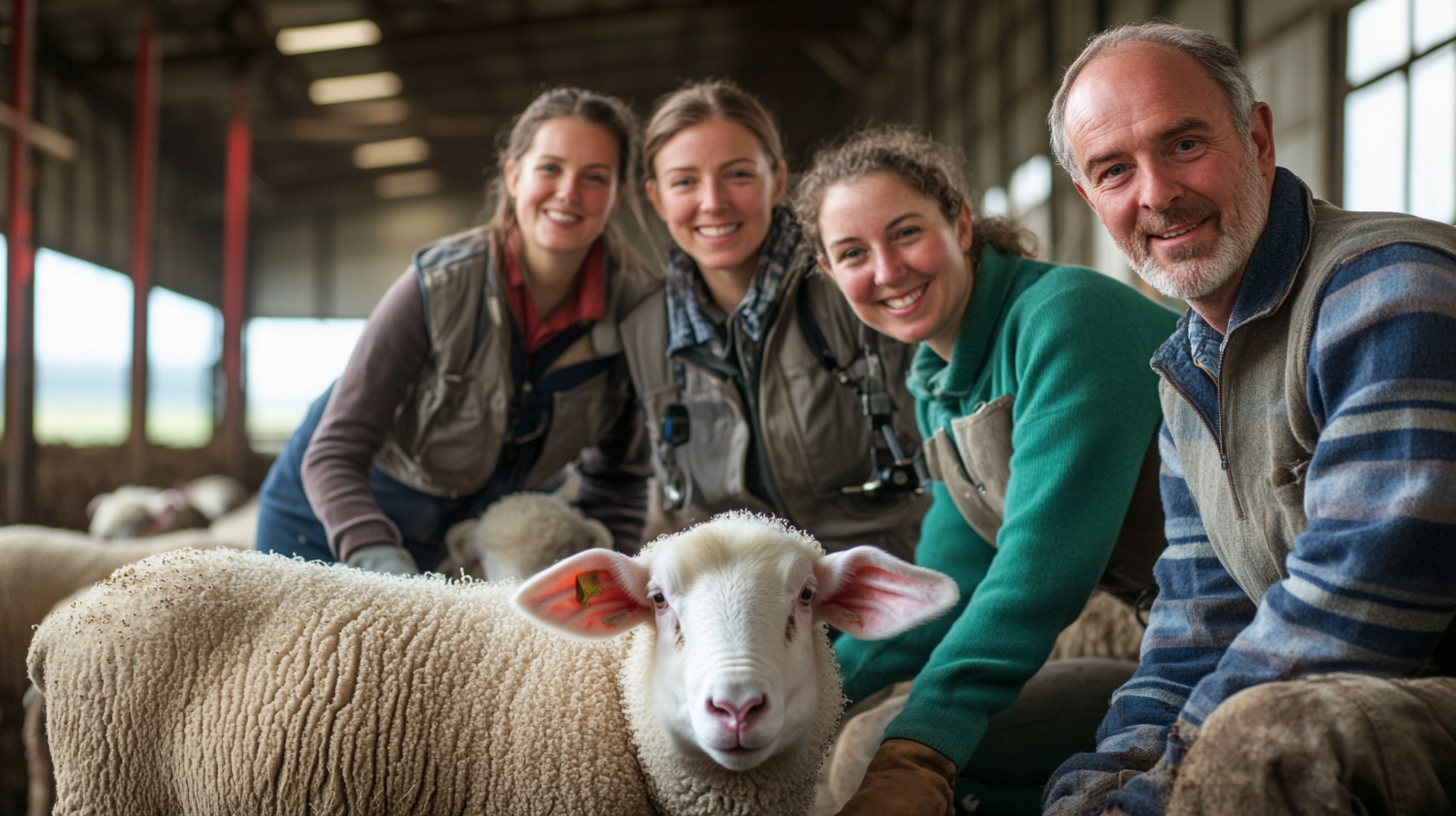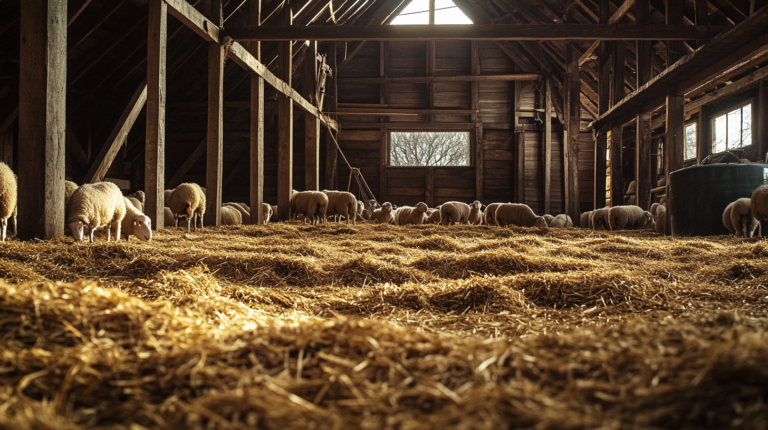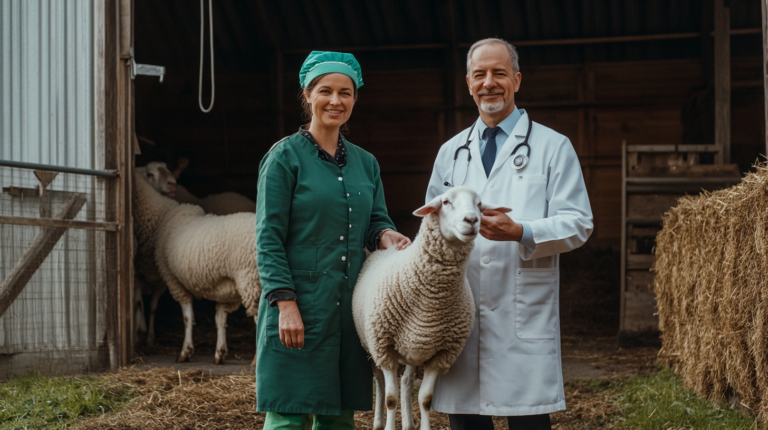Discover the 5 early warning signs of Johne’s Disease in Sheep and learn effective management strategies to protect your flock from this devastating bacterial infection.
Table of Contents
Johne’s disease, also known as paratuberculosis, is a chronic, progressive bacterial infection that affects sheep and other ruminants, causing significant economic losses for farmers worldwide. This debilitating condition, caused by the bacterium Mycobacterium avium subspecies paratuberculosis (MAP), can remain undetected in a flock for years before clinical signs become apparent. By the time symptoms are noticeable, the disease has often spread throughout the flock, making early detection and management crucial for controlling this devastating illness. This comprehensive guide explores the five early warning signs of Johne’s disease in sheep, along with effective management strategies to help shepherds and flock owners protect their animals and livelihoods.

What is Johne’s Disease in Sheep?
Johne’s disease is a chronic enteritis (intestinal inflammation) caused by infection with MAP, a slow-growing, acid-fast bacterium that persists in the environment for extended periods. The disease primarily affects the small intestine, interfering with nutrient absorption and eventually leading to progressive weight loss and death. While cattle are often the focus of Johne’s disease research and control programs, sheep are equally susceptible, though the manifestation of the disease may differ slightly between species.
The Lifecycle of Johne’s Disease
Understanding the progression of Johne’s disease is essential for early detection and effective management:
- Infection Stage: Young lambs (typically under six months of age) are most susceptible to infection. The bacteria enter the body through ingestion of contaminated feed, water, milk, or colostrum.
- Silent Stage: After infection, the bacteria multiply slowly in the intestinal wall and regional lymph nodes. During this stage, which can last 2-5 years, infected sheep show no clinical signs but may shed the bacteria in their feces, potentially infecting other animals.
- Subclinical Stage: As the infection progresses, sheep begin to shed more bacteria in their feces but still display minimal or no visible symptoms. This makes detection particularly challenging without laboratory testing.
- Clinical Stage: Eventually, the infection causes visible symptoms, including progressive weight loss despite normal appetite, ultimately leading to death.
5 Early Signs of Johne’s Disease in Sheep
Early detection of Johne’s disease provides the best opportunity for controlling its spread within a flock. Here are the five early warning signs to watch for:
1. Subtle Weight Loss Despite Normal Appetite
One of the earliest and most consistent signs of Johne’s disease in sheep is a gradual loss of body condition despite normal or even increased feed intake. This occurs because the infected intestine can no longer efficiently absorb nutrients from food.
What to look for:
- Sheep that appear thinner than their flockmates
- Visible loss of muscle mass, particularly around the loin and hindquarters
- Animals that eat well but fail to maintain weight
- Gradual decline in body condition score over weeks or months
Unlike sudden weight loss associated with acute diseases, the weight loss in Johne’s disease is insidious and progressive. Regular body condition scoring of your flock can help identify affected animals before the weight loss becomes severe.
2. Changes in Fleece Quality and Appearance
The nutritional deficiencies caused by Johne’s disease often manifest in the quality and appearance of a sheep’s fleece, providing an early visual indicator of potential infection.
What to look for:
- Dull, brittle, or poor-quality wool
- Abnormal shedding or “wool break”
- Loss of wool color or luster
- Excessive wool loss or patches of thin fleece
According to a study published in the Journal of Veterinary Diagnostic Investigation, approximately 68% of sheep with confirmed Johne’s disease showed noticeable deterioration in fleece quality in the early stages of clinical disease, making this an important indicator for shepherds to monitor.
3. Subtle Changes in Behavior and Energy Levels
Sheep with early Johne’s disease may exhibit subtle behavioral changes that can be easily overlooked if not carefully observed.
What to look for:
- Reduced participation in normal flock activities
- Lagging behind the flock during movement
- Decreased energy levels or stamina
- Increased time spent lying down or resting
- Reduced competitive behavior at feeding time
These behavioral changes typically precede more obvious clinical signs and may be present months before significant weight loss becomes apparent. Shepherds who know their flocks well are often the first to notice these subtle alterations in normal behavior patterns.
4. Intermittent Soft Feces Without Obvious Diarrhea
While severe, watery diarrhea is a classic sign of advanced Johne’s disease in cattle, sheep often present differently. In the early stages, affected sheep may show only intermittent changes in fecal consistency.
What to look for:
- Soft, unformed feces that are not quite diarrhea
- Intermittent episodes of looser stool followed by normal pellets
- Slight soiling of the wool around the tail and hindquarters
- Fresh manure staining on the legs or fleece
These fecal changes are often subtle and may come and go, making them easy to miss without regular observation. Approximately 40-60% of sheep with early Johne’s disease show these intermittent fecal changes according to research from the University of Sydney’s Farm Animal Health team.
5. Reduced Reproductive Performance
Sheep with subclinical Johne’s disease often experience reduced reproductive efficiency before other signs become apparent, making reproductive records a valuable tool for early detection.
What to look for:
- Decreased conception rates
- Increased early embryonic loss
- Reduced milk production leading to poor lamb growth
- Lower twinning rates in previously prolific ewes
- Shorter productive lifespan
A long-term study by the National Animal Disease Center found that ewes with Johne’s disease produced 15-20% fewer lambs over their lifetime compared to uninfected flockmates, with the decline beginning well before clinical signs appeared.
Diagnosing Johne’s Disease in Sheep
Early diagnosis of Johne’s disease is challenging due to the slow progression of the infection and the subtlety of early signs. However, several diagnostic tests are available:
Blood Testing (ELISA)
The enzyme-linked immunosorbent assay (ELISA) detects antibodies against MAP in blood samples. While convenient and relatively inexpensive, ELISA has limitations:
- Lower sensitivity in early infection stages (30-40% in subclinical cases)
- More effective in detecting advanced cases
- May produce false positives due to cross-reactions with other mycobacteria
Fecal Culture
Fecal culture is considered the gold standard for diagnosis but has significant drawbacks:
- Extremely slow (taking 8-16 weeks for results due to the slow-growing nature of MAP)
- Requires specialized laboratory facilities
- Expensive when testing large numbers of animals
- More reliable in clinical cases than subclinical ones
PCR Testing
Polymerase chain reaction (PCR) testing detects MAP DNA in fecal samples:
- Faster than culture (results within days)
- Moderate to high sensitivity
- Can detect subclinical shedders
- More expensive than ELISA
- May detect dead bacteria, not just active infections
Post-Mortem Examination
Necropsy remains one of the most definitive ways to diagnose Johne’s disease:
- Characteristic thickening and corrugation of the intestinal lining
- Enlarged mesenteric lymph nodes
- Histopathological confirmation through tissue analysis
- Obviously limited to deceased animals, not useful for early detection
Management Strategies for Johne’s Disease in Sheep
Once Johne’s disease is identified or suspected in a flock, implementing comprehensive management strategies is essential. While complete eradication is challenging, the following approaches can help control the spread and minimize economic impact:
1. Testing and Culling Programs
Implementing a systematic testing and culling program is fundamental to controlling Johne’s disease:
- Regular Testing: Test the entire adult flock annually using ELISA or PCR.
- Strategic Culling: Remove test-positive animals as soon as economically feasible.
- Prioritized Culling: Focus first on animals showing clinical signs or high test values.
- Offspring Management: Consider removing offspring of confirmed positive ewes, as they have a high risk of infection.
Research from Australia’s Ovine Johne’s Disease Control Program demonstrated that flocks implementing consistent testing and culling reduced disease prevalence by 70-80% over five years when combined with good biosecurity measures.
2. Lambing Management
Since young lambs are most susceptible to infection, lambing management is critical:
- Clean Lambing Areas: Provide clean, uncontaminated areas for lambing.
- Separate Lambing Pens: Use individual lambing pens when possible for high-value flocks.
- Quick Removal: Remove lambs from potentially contaminated environments as soon as possible.
- Colostrum Management: Consider feeding colostrum from test-negative ewes or heat-treated colostrum to reduce transmission risk.
Studies from New Zealand’s sheep industry indicate that improved lambing management alone can reduce new infection rates by 40-50% in affected flocks.
3. Pasture and Grazing Management
Strategic pasture management helps break the cycle of infection:
- Rotational Grazing: Implement a rotational grazing system to reduce bacterial buildup.
- Rest Periods: Allow pastures to rest for at least 6-12 months before reintroducing susceptible young animals.
- Drainage Improvement: Improve drainage in wet areas where the bacteria can survive longer.
- Avoid Mixed Grazing: When possible, avoid grazing young stock on pastures recently used by adult animals.
The University of Wisconsin’s Johne’s Information Center reports that well-managed rotational grazing systems can reduce environmental contamination by 30-60% compared to continuous grazing in the same areas.
4. Biosecurity Measures
Preventing the introduction of Johne’s disease into unaffected flocks is easier than controlling it once established:
- Closed Flock Policy: Maintain a closed flock when possible, breeding your own replacements.
- Testing New Additions: If purchasing new animals, source them from flocks with Johne’s disease testing programs.
- Quarantine Procedures: Quarantine and test new animals before introducing them to the main flock.
- Equipment Sanitation: Clean and disinfect shared equipment that may be contaminated with manure.
The American Sheep Industry Association estimates that implementing comprehensive biosecurity measures can reduce the risk of introducing Johne’s disease by up to 90%.
5. Nutritional Management
While nutrition cannot prevent or cure Johne’s disease, proper nutritional support can help affected animals maintain condition longer:
- High-Quality Forage: Provide easily digestible, high-quality forage.
- Strategic Supplementation: Supplement with easily absorbed nutrients.
- Parasite Control: Maintain effective parasite control to reduce additional stress on the digestive system.
- Trace Mineral Support: Ensure adequate trace mineral nutrition to support immune function.
6. Vaccination Considerations
Vaccination against Johne’s disease in sheep has shown variable results:
- Available in some countries but not universally
- Reduces clinical disease and bacterial shedding but does not prevent infection
- May interfere with tuberculosis testing in some situations
- Cost-effective in heavily infected flocks as part of a comprehensive control program
A long-term study by the Moredun Research Institute found that vaccination reduced clinical cases by approximately 90% in heavily infected flocks, though subclinical infection persisted.
7. Record Keeping and Monitoring
Comprehensive records are essential for effective Johne’s disease management:
- Individual Animal Identification: Maintain reliable identification for all animals.
- Testing History: Document all test results with dates and outcomes.
- Weight Records: Track weight changes over time to identify suspicious patterns.
- Reproductive Performance: Monitor breeding records for signs of declining fertility.
- Culling Decisions: Document reasons for culling to identify disease patterns.
Economic Impact of Johne’s Disease in Sheep
The financial burden of Johne’s disease extends beyond the obvious losses from deceased animals:
| Impact Category | Estimated Annual Loss per Affected Flock |
| Reduced lamb production | 15-25% |
| Premature culling | 5-15% of adult ewes |
| Decreased wool production | 10-20% |
| Reduced carcass value | 8-12% |
| Treatment and testing costs | Variable |
| ost genetic potential | Incalculable |
According to the Australian Wool Innovation Limited, the total economic impact of Johne’s disease in affected flocks can range from $7 to $23 per ewe annually, highlighting the significant financial incentive for implementing control measures.
Recommended Products on Amazon
Title: Recommended Pet Products on Amazon
- Premier Sheep Vaccination Gun Kit – Essential for administering vaccines and medications as part of your Johne’s disease management program.
- Sheep Body Condition Scoring Chart – Laminated reference guide to help monitor weight changes, a critical early sign of Johne’s disease.
- Digital Livestock Scale – Accurate weight monitoring system for tracking subtle weight changes in your flock.
- Premium Sheep Mineral Supplement – High-quality mineral supplement formulated to support immune function and overall health in sheep.
Frequently Asked Questions About Johne’s Disease in Sheep
Can humans get Johne’s disease from infected sheep?
The bacterium that causes Johne’s disease, Mycobacterium avium subspecies paratuberculosis (MAP), has been associated with Crohn’s disease in humans, though a definitive causal relationship remains controversial. While the risk of zoonotic transmission is considered low, basic hygiene precautions when handling infected animals are recommended.
How long can Johne’s disease bacteria survive in the environment?
MAP is extremely hardy and can survive in soil and water for extended periods:
- In shaded soil: 12+ months
- In water: 6-18 months
- In dry, sunny environments: 3-6 months This environmental persistence makes complete elimination extremely challenging without long-term management.
Is Johne’s disease treatable in sheep?
Currently, there is no effective treatment for Johne’s disease in sheep. Antibiotics may temporarily reduce bacterial shedding but do not eliminate the infection. Management focuses on controlling spread rather than treating individual animals.
How is Johne’s disease different in sheep compared to cattle?
While the causative agent is the same, sheep typically show less dramatic diarrhea than cattle with Johne’s disease. Sheep more commonly present with progressive weight loss without severe diarrhea, and the disease progression is often faster in sheep than in cattle.
Can vaccination completely prevent Johne’s disease?
No, vaccination does not prevent infection but can reduce clinical disease and bacterial shedding. Vaccinated animals can still become infected and potentially spread the disease, though at lower rates than unvaccinated animals.
At what age are sheep most susceptible to Johne’s disease?
Lambs under six months of age are most susceptible to infection, with susceptibility decreasing with age. Adult sheep can become infected but require higher exposure doses and are less likely to develop clinical disease.
How quickly does Johne’s disease spread through a flock?
The spread rate depends on many factors, including management practices, stocking density, and environmental conditions. In intensively managed flocks with high stocking rates, prevalence can increase from a few percent to 30-50% within 3-5 years without control measures.
Moving Forward: Creating a Johne’s Disease Control Plan
Developing a flock-specific control plan is essential for effectively managing Johne’s disease. Consider these steps:
- Assess Current Status: Determine if Johne’s disease is present through testing.
- Set Goals: Decide whether the goal is eradication (possible in mildly affected flocks) or control (more realistic in heavily affected flocks).
- Implement Testing: Establish a regular testing schedule appropriate for your flock size and resources.
- Develop Management Protocols: Create specific protocols for lambing, culling, and biosecurity.
- Monitor Progress: Track testing results over time to assess effectiveness.
- Adjust as Needed: Modify the control plan based on results and new research.
Before implementing any Johne’s disease control program, consulting with a veterinarian experienced in small ruminant health is strongly recommended to develop a customized approach for your specific situation.
Conclusion
Johne’s disease represents a significant challenge for sheep producers worldwide, but early detection and comprehensive management can substantially reduce its impact. By understanding the early signs—subtle weight loss, fleece changes, behavioral alterations, intermittent soft feces, and reduced reproductive performance—shepherds can identify potentially infected animals before the disease spreads extensively through the flock.

While complete eradication may be difficult, implementing testing, culling, improved lambing management, pasture rotation, and strong biosecurity measures can effectively control Johne’s disease over time. The economic benefits of these control measures typically far outweigh their costs, particularly when considering the long-term sustainability of the flock.
Have you encountered Johne’s disease in sheep your flock? Share your experience or questions in the comments below to help others facing similar challenges.





